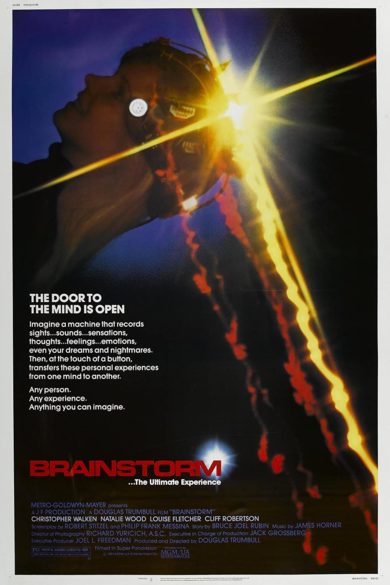 An ambitious disaster from 1983 that, given the level of talent involved, starting with its producer-director Douglas Trumbull (1942-2002), shouldn’t be that awful—but I’m afraid BRAINSTORM really IS that awful.
An ambitious disaster from 1983 that, given the level of talent involved, starting with its producer-director Douglas Trumbull (1942-2002), shouldn’t be that awful—but I’m afraid BRAINSTORM really IS that awful.
I’m afraid BRAINSTORM really IS that awful.
In fairness, the film’s production was a troubled one. Headlining was the 43 year old former starlet Natalie Wood, in what was to be her Hollywood comeback, but that ambition was stymied on the evening of November 28, 1981, when during a break in filming she drowned off the coast of Catalina. Trumbull was able to complete the film, only to have it dumped by its distributor MGM, leading to the severely disillusioned Trumbull’s permanent defection from Hollywood.
Trumbull was an FX legend whose credits as a visual effects supervisor included 2001: A SPACE ODYSSEY, CLOSE ENCOUNTERS OF THE THIRD KIND, STAR TREK: THE MOTION PICTURE and BLADE RUNNER. For BRAINSTORM, his second outing as a director (the first being SILENT RUNNING from 1972), Trumbull attracted an impressive array of talent, which in addition to Wood included the Oscar wining trio of Christopher Walken, Cliff Robertson and Louise Fletcher. Trumbull had intended for the film to be lensed and exhibited entirely in his self-created Showscan format, which exhibited films at 60 frames per second (in place of the standard 24). When that proved too costly he decided to use Showscan only in certain scenes, and then not at all.
Trumbull had intended for the film to be lensed and exhibited entirely in his self-created Showscan format, which exhibited films at 60 frames per second (in place of the standard 24).
The script, adapted from a 1970s-era screenplay entitled THE GEORGE DUNLAP TAPE by Bruce Joel Rubin, posits the existence of a technology that allows its users to imprint their consciousness on tape so it can be experienced by others (a concept utilized much better in the 1995 film STRANGE DAYS). Among the scientists involved in the device’s creation are the estranged couple Michael and Karen, who get back together when Michael records his memories and allows Karen to experience them. There’s also Lillian, Michael’s partner, who dies of a heart attack at work and records her death, and Alex, the group’s government-affiliated leader, who’s responsible for the development of a “Project Brainstorm” that utilizes the consciousness-recording technology for evil.
That about sums up a severely under-baked and meandering narrative. That Trumbull was a special effects man by trade is evident in the sleepwalking performances and clumsy storytelling (with pivotal characters, such as Michael and Karen’s son, who’s driven mad by the Brainstorm Project, introduced and then shockingly discarded). Visually Trumbull made a common mistake of technicians-turned-directors: he promoted his longtime partner, Richard Yuricich, to director of photography. BRAINSTORM remains Yuricich’s sole feature DOP credit, and there’s a reason for that.
BRAINSTORM remains Yuricich’s sole feature DOP credit, and there’s a reason for that.
 Natalie Wood’s work suffers especially. Trumbull claimed that most of her scenes had been shot at the time of her death and only a few pick-up shots were needed to complete the film, yet nearly every scene in which she appears feels awkward and disjointed. Poorly juxtaposed wide shots and haphazardly placed reactions abound in sequences that at times don’t even approach professional level.
Natalie Wood’s work suffers especially. Trumbull claimed that most of her scenes had been shot at the time of her death and only a few pick-up shots were needed to complete the film, yet nearly every scene in which she appears feels awkward and disjointed. Poorly juxtaposed wide shots and haphazardly placed reactions abound in sequences that at times don’t even approach professional level.
The special effects, as you’d expect, are strong, albeit unexceptional. The climactic 2001-esque depiction of heaven and hell, as experienced by the dying Lillian, was groundbreaking in its day but not anymore. The consciousness-POV shots are likewise quite dated, utilized as they are with distorted fisheye lenses (to match the “memory bubble” effect, in which taped memories are depicted via rows of bubble-like spheres). Trumbull also has a tendency to cheat in these scenes, frequently showing the seer in the scene together with what s/he is supposed to be seeing.
The climactic 2001-esque depiction of heaven and hell, as experienced by the dying Lillian, was groundbreaking in its day but not anymore.
One unquestionably strong component is the haunting and magisterial score by James Horner. One of eight films Horner scored in 1983 (others include KRULL and SOMETHING WICKED THIS WAY COMES), BRAINSTORM’S music is among his best work, and has been replayed quite extensively elsewhere. It’s just a shame it originated with this movie.
Vital Statistics
BRAINSTORM
Metro-Goldwyn-Meyer
Director/Producer: Douglas Trumbull
Screenplay: Robert Stitzel, Philip Frank Messina
Cinematography: Richard Yuricich
Editing: Freeman Davies, Edward Warschilka
Cast: Christopher Walken, Natalie Wood, Cliff Robertson, Louise Fletcher, Jordan Christopher, Donald Hotton, Alan Fudge, Joe Dorsey, Bill Morey, Jason Lively, Darrell Larson, Lou Walker
